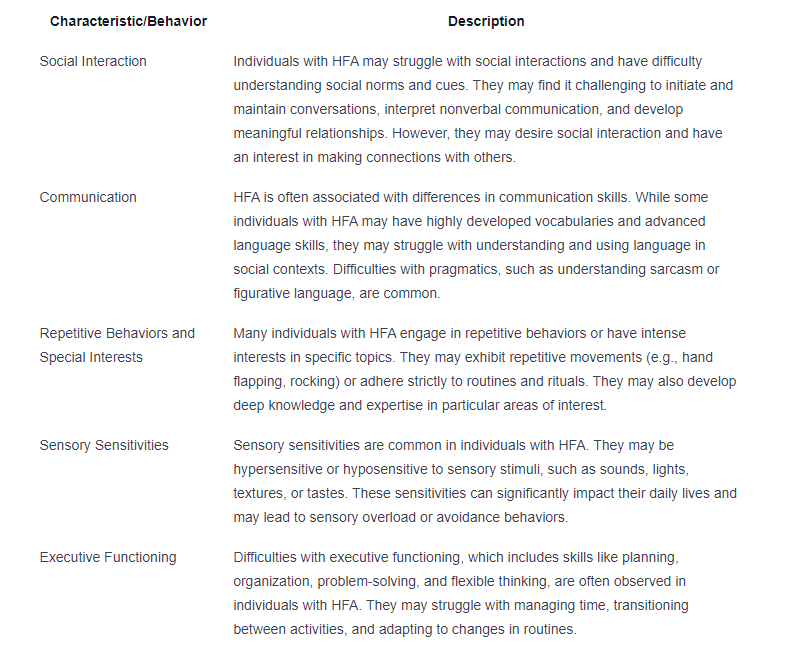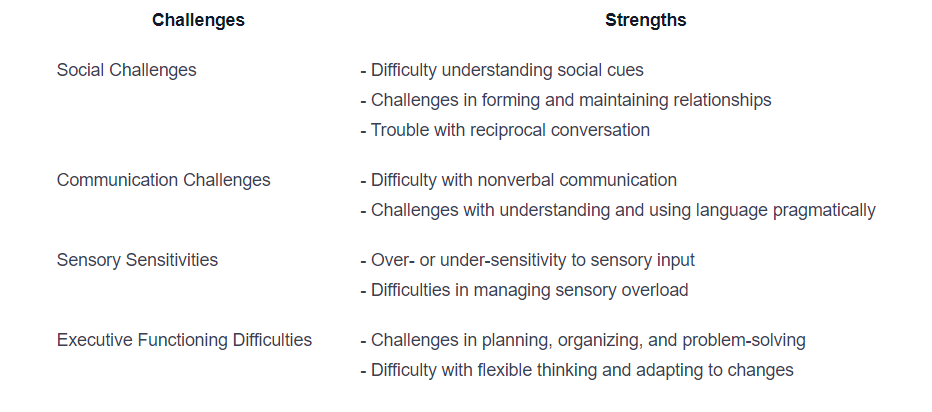High-Functioning Autism vs. Low-Functioning Autism
Unlocking the diagnosis of autism spectrum disorder: Understand the spectrum, levels of functioning, and individualized support.

Understanding Autism Spectrum Disorder (ASD)
Autism Spectrum Disorder (ASD) is a neurodevelopmental disorder that affects individuals in different ways, leading to challenges in social interaction, communication, and behavior. It is a complex condition that manifests on a spectrum, with individuals experiencing a wide range of abilities and characteristics.
What is Autism Spectrum Disorder?
Autism Spectrum Disorder, often referred to as ASD, is a lifelong condition that typically emerges in early childhood. It is characterized by difficulties in social interaction, communication, and repetitive or restricted patterns of behavior. ASD affects people of all races, ethnicities, and socioeconomic backgrounds, with varying severity and impact on daily functioning.
Key Features of Autism Spectrum Disorder
Autism Spectrum Disorder is marked by several key features that help define the condition. These include:
- Impaired Social Interaction: Individuals with ASD often struggle with social interactions and may have difficulty understanding and responding to social cues. They may find it challenging to establish and maintain relationships, both with peers and adults.
- Communication Difficulties: Language and communication difficulties are common in individuals with ASD. Some individuals may have delayed speech or be nonverbal, while others may have a rich vocabulary but struggle with pragmatic language skills, such as understanding sarcasm or taking turns in conversation.
- Restricted and Repetitive Behaviors: People with ASD often engage in repetitive behaviors, such as repetitive movements or the need for strict routines. They may also have highly focused interests in specific topics, objects, or activities.
- Sensory Sensitivities: Many individuals with ASD experience sensory sensitivities, such as being hypersensitive or hyposensitive to certain stimuli. This can include sensitivity to loud noises, bright lights, or certain textures.
- Strengths and Challenges: While ASD presents challenges, individuals with ASD also have unique strengths and abilities. Some individuals may excel in areas such as mathematics, music, or visual thinking. It's important to recognize and nurture these strengths.
Understanding the key features of Autism Spectrum Disorder is crucial for recognizing and providing appropriate support to individuals on the spectrum. By promoting acceptance, understanding, and tailored interventions, we can create a more inclusive and supportive environment for individuals with ASD.
The Spectrum of Autism
Autism Spectrum Disorder (ASD) is a complex neurodevelopmental condition that is characterized by a wide range of behaviors, challenges, and abilities. The spectrum of autism encompasses individuals with varying levels of functioning, including high-functioning autism (HFA) and low-functioning autism (LFA).
Different Levels of Functioning
Within the autism spectrum, individuals can exhibit different levels of functioning. This refers to the degree of support and assistance needed to navigate daily life. It's important to note that functioning levels can vary greatly among individuals with autism, and each person is unique in their abilities and challenges.
High-Functioning Autism (HFA)
High-functioning autism (HFA), also known as Level 1 Autism Spectrum Disorder, is typically characterized by individuals who have average to above-average intelligence and language skills. They may excel in certain areas, such as academics or specific interests, while still experiencing challenges related to social interaction and communication.
Characteristics of High-Functioning Autism (HFA)
Average to above-average intelligence
Good verbal and nonverbal communication skills
Strong memory and attention to detail
Difficulty with social interactions and understanding social cues
Special interests or intense focus on specific topics
Strong adherence to routines and difficulty with change
It's important to recognize that individuals with HFA have unique strengths and challenges, and their needs should be addressed through individualized support and interventions.
Low-Functioning Autism (LFA)
Low-functioning autism (LFA), also known as Level 3 Autism Spectrum Disorder, is characterized by individuals who require substantial support across multiple areas of functioning. Individuals with LFA may have significant impairments in communication, social interaction, and adaptive skills.
Characteristics of Low-Functioning Autism (LFA)
Intellectual disability or developmental delays
Limited verbal and nonverbal communication skills
Challenges with daily living activities
Difficulty with social interactions and understanding social cues
Repetitive and stereotyped behaviors
Sensory sensitivities
Individuals with LFA may require assistance with daily tasks, such as personal care, and benefit from structured environments and specialized interventions tailored to their unique needs.
Understanding the different levels of functioning within the autism spectrum is crucial for providing appropriate support and interventions to individuals with autism. By recognizing the strengths and challenges of both high-functioning autism (HFA) and low-functioning autism (LFA), we can promote acceptance, inclusion, and individualized support for individuals across the spectrum.
Diagnosis of Autism Spectrum Disorder
Accurate diagnosis is key to understanding and providing support for individuals with Autism Spectrum Disorder (ASD). The diagnostic process involves a comprehensive evaluation to determine if an individual meets the criteria for ASD. Let's explore the steps involved in the diagnostic process, the diagnostic criteria for ASD, and the assessments and evaluations used.
The Diagnostic Process
The diagnostic process for ASD typically involves multiple steps and assessments. It begins with a comprehensive interview and observation of the individual's behaviors and developmental history. This includes gathering information from parents, caregivers, teachers, and other relevant individuals who interact with the person regularly.
To assist in the diagnostic process, healthcare professionals, such as psychologists, psychiatrists, or developmental pediatricians, may use standardized tools and questionnaires. These tools help assess various areas of development, behavior, and social functioning. The diagnostic process also considers any additional factors that may contribute to the individual's symptoms, such as medical conditions or genetic factors.
Diagnostic Criteria for ASD
The diagnostic criteria for ASD are outlined in the Diagnostic and Statistical Manual of Mental Disorders (DSM-5). The DSM-5 provides a standardized framework for diagnosing mental disorders, including ASD. To receive a diagnosis of ASD, an individual must meet the criteria specified in the DSM-5.
The DSM-5 criteria for ASD include persistent deficits in social communication and social interaction across multiple contexts. Additionally, restricted and repetitive patterns of behavior, interests, or activities must be present. These symptoms must be observed during early childhood and cause significant impairment in daily functioning.
Assessments and Evaluations
During the diagnostic process, various assessments and evaluations are used to gather information and evaluate the individual's strengths and challenges. These assessments may include:
- Developmental assessments: These assessments evaluate the individual's development in areas such as language, motor skills, and cognitive abilities.
- Cognitive assessments: These assessments measure the individual's intellectual functioning and may include tests such as IQ tests.
- Behavioral assessments: These assessments focus on observing and analyzing the individual's behavior in different settings and situations.
- Social skills assessments: These assessments evaluate the individual's social skills and social interaction abilities.
- Communication assessments: These assessments assess the individual's communication skills, including both verbal and nonverbal communication.
- Adaptive functioning assessments: These assessments measure the individual's ability to function independently in daily life activities, such as self-care, communication, and problem-solving.
By utilizing these assessments and evaluations, healthcare professionals can gather comprehensive information about the individual's strengths, challenges, and specific support needs. This information forms the basis for an accurate diagnosis and helps in developing individualized interventions and strategies to support individuals with ASD.
The diagnostic process, along with the criteria and assessments used, ensures that individuals with ASD receive the appropriate support and interventions tailored to their unique needs. Early diagnosis and intervention play a crucial role in promoting positive outcomes and enhancing the quality of life for individuals with ASD.
Identifying High-Functioning Autism (HFA)
High-Functioning Autism (HFA) is a term used to describe individuals on the autism spectrum who have average or above-average intellectual abilities. While each person with HFA is unique, there are common characteristics and behaviors that can help identify this subtype of autism.
Characteristics and Behaviors

Challenges and Strengths

Identifying high-functioning autism involves recognizing these characteristics, behaviors, and the unique challenges and strengths that individuals with HFA possess. It is essential to understand and appreciate the diverse characteristics of individuals on the autism spectrum to provide appropriate support and foster their strengths.
Understanding Low-Functioning Autism (LFA)
Autism Spectrum Disorder (ASD) is a complex neurodevelopmental disorder that encompasses a wide range of abilities and challenges. Within the spectrum, individuals may exhibit varying levels of functioning. In this section, we will focus on low-functioning autism (LFA) and explore its characteristics, behaviors, and the support needs of individuals with this level of functioning.
Characteristics and Behaviors
Low-functioning autism (LFA) is typically associated with significant impairments in communication, social interaction, and repetitive behaviors. Here are some common characteristics and behaviors often observed in individuals with LFA:
- Communication difficulties: Individuals with LFA may have limited or no verbal language skills. They may rely on alternative forms of communication, such as gestures, pictures, or assistive devices. Some individuals may also experience challenges in understanding and interpreting nonverbal cues.
- Social interaction challenges: Interacting and forming relationships with others can be challenging for individuals with LFA. They may struggle with the skills needed for social engagement, such as initiating and maintaining conversations, understanding social norms, and interpreting emotions.
- Repetitive and restrictive behaviors: Repetitive behaviors, including repetitive movements, fixated interests, and adherence to routines, are commonly observed in individuals with LFA. These behaviors often serve as a source of comfort and predictability.
- Sensory sensitivities: Many individuals with LFA experience sensory sensitivities, where certain sounds, textures, or lights may be overwhelming. These sensitivities can affect their ability to engage in everyday activities and may lead to distress or meltdowns.
Challenges and Support Needs
Individuals with low-functioning autism (LFA) face unique challenges that require tailored support and interventions. Some of the key challenges and support needs include:
- Daily living skills: Individuals with LFA may require assistance and training to develop and maintain essential daily living skills, such as personal hygiene, self-care, and meal preparation. Occupational therapy and structured routines can be helpful in promoting independence in these areas.
- Communication and social skills: Communication interventions, such as augmentative and alternative communication systems, can enhance the ability of individuals with LFA to express their needs and engage in social interactions. Social skills training and social stories can also help develop social understanding and interaction skills.
- Behavior management: The presence of repetitive behaviors and sensory sensitivities in individuals with LFA may require behavior management strategies. Applied Behavior Analysis (ABA) and sensory integration therapy can be beneficial in addressing challenging behaviors and sensory issues.
- Education and learning support: Individuals with LFA often require specialized education programs that cater to their unique learning needs. These programs can focus on individualized instruction, visual supports, and the use of structured teaching approaches to maximize learning outcomes.
By understanding the characteristics, behaviors, and support needs of individuals with low-functioning autism (LFA), we can ensure that appropriate interventions and strategies are in place to promote their well-being, development, and quality of life. It is essential to approach each individual with empathy, respect, and a commitment to providing individualized support.
The Importance of Individualized Support
When it comes to Autism Spectrum Disorder (ASD), individualized support plays a crucial role in ensuring the well-being and development of individuals on the spectrum. Understanding the unique needs and strengths of each person with ASD allows for tailored interventions and strategies that can make a significant difference in their lives.
Tailoring Interventions and Strategies
One of the key aspects of individualized support is the customization of interventions and strategies to meet the specific needs of individuals with ASD. What works for one person may not work for another, as each individual on the autism spectrum is unique in their abilities, challenges, and preferences.
By tailoring interventions, therapists, educators, and caregivers can address the specific areas of difficulty for individuals with ASD. These interventions may include behavioral therapies, social skills training, speech and language therapy, occupational therapy, and other evidence-based approaches. The goal is to provide support that promotes their social, communicative, cognitive, and adaptive skills.
It is important to note that the effectiveness of interventions can vary among individuals. Ongoing assessment and monitoring of progress are essential to modify and adjust interventions as needed. Regular communication and collaboration between professionals, families, and individuals with ASD are crucial in ensuring that the interventions are responsive to their evolving needs.
Promoting Inclusion and Acceptance
In addition to tailored interventions, promoting inclusion and acceptance is another vital aspect of individualized support for individuals with ASD. It is important to create an environment that embraces diversity and recognizes the strengths and contributions of individuals on the autism spectrum.
Promoting inclusion involves providing opportunities for individuals with ASD to participate fully in various aspects of life, such as education, employment, recreation, and social interactions. This can be achieved through accommodations and modifications that support their unique learning styles, sensory sensitivities, and communication needs.
Acceptance is equally important in fostering a supportive environment for individuals with ASD. It involves embracing neurodiversity and challenging societal stigmas and stereotypes associated with autism. By promoting acceptance, we can encourage a more inclusive society that values the contributions and potential of individuals with ASD.
By recognizing the importance of individualized support, tailoring interventions and strategies, and promoting inclusion and acceptance, we can create a more inclusive and supportive environment for individuals with Autism Spectrum Disorder. Through this approach, we can empower individuals with ASD to reach their full potential and lead fulfilling lives.
Sources
https://www.verywellhealth.com/high-and-low-functioning-autism-260599
https://www.songbirdcare.com/articles/low-functioning-autism
https://www.abtaba.com/blog/low-functioning-autism
Similar articles
We’re here to help you

Our team is here to assist you in this process. Contact us for any assistance.
it’s easy to apply
We Accept Most Insurances
Our in-network insurance partnerships make ABA therapy more accessible to families throughout our service areas.







Our Insurance Process
We'll request your insurance details to help us verify your plan's coverage for ABA therapy. Once we've received this information, we'll walk you through your benefits, including copayments, deductibles and out-of-pocket maximums, so you know what to expect in advance.
Our team will then handle the preauthorization and all the necessary paperwork.
.svg)





















.jpeg)


































.jpeg)




.jpeg)







.jpeg)











.jpeg)
















